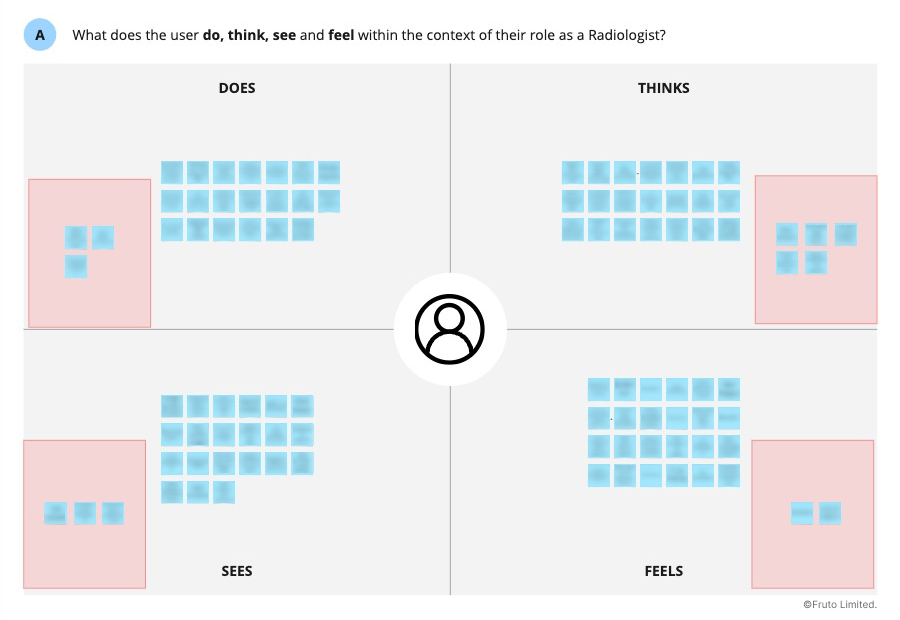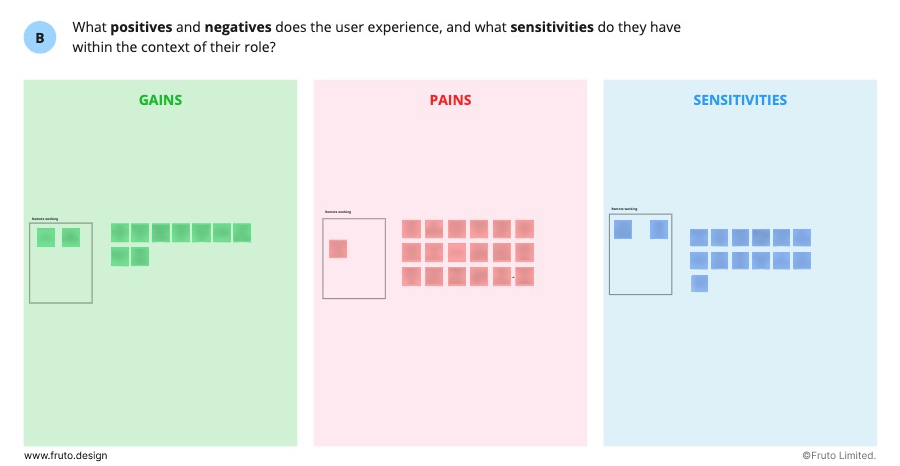What they needed
Blackford aimed to showcase a new product capability at the Radiological Society of North America (RSNA) conference in Chicago. For that, they needed an interactive MVP prototype to rapidly test and validate their product concept, allowing them to showcase a compelling prototype at the conference and gather valuable feedback from prospective partners and customers.
What we did for them
Understanding user needs & workflow
We started with a kick-off meeting to define project objectives, user needs, and technical constraints. To gain a deep understanding of the radiologist workflow, we conducted a user journey mapping workshop, structuring the journey around six key phases: Prepare, Discovery, Review, Report, Handover, and Finish.
Our user journey mapping explored multiple layers:
User steps – The specific actions radiologists take at each stage.
Tasks – The tasks they complete throughout their workflow.
Environment & other personas – Their physical workspace and interactions with colleagues.
Thoughts & feelings – What they are thinking and feeling at different points in the journey.
Pain points – Key challenges and frustrations within the workflow.
Opportunities – Areas where the experience could be improved.
We also conducted an empathy mapping exercise, identifying what radiologists do, think, see, and feel within the context of their role. This helped us uncover their motivations, frustrations, and expectations when interacting with digital tools. Additionally, we ran a Gains & Pains activity, mapping out both the positives and challenges radiologists face, along with any sensitivities that could impact how they engage with a new product.
We built a detailed picture of the radiologist’s workflow, mindset, and challenges, ensuring that the design aligned with their real-world needs and pain points.

User journey mapping | The text in this image has been intentionally blurred to maintain confidentiality.

Empathy mapping | The text in this image has been intentionally blurred to maintain confidentiality.

Pains & Gains mapping | The text in this image has been intentionally blurred to maintain confidentiality.
UI prototyping
We designed a clickable prototype to bring the concept to life and allow for early testing. This included:
Creating high-fidelity UI designs to ensure a polished and intuitive experience.
Designing interactive elements to simulate real-world usage, making it easier to gather meaningful feedback.
Iterating quickly based on initial insights, refining the layout, navigation, and interactions.
Ensuring consistency with existing design systems and branding while optimising for usability.
The prototype provided a realistic representation of the user experience, allowing stakeholders to evaluate the design and functionality before development.
Usability testing with US-based radiologists
To validate the design, we conducted remote usability testing with seven radiologists across the US, ensuring a diverse range of experience levels, work environments, and hospital settings. We also managed the user recruitment process, working with a third-party research agency to find participants who accurately represented the target user base.
Our usability testing process included:
Task-based testing – Participants interacted with the prototype in real-world scenarios, allowing us to evaluate usability and identify friction points.
Observational & attitudinal insights – By documenting user behaviours, feedback, and pain points, we uncovered common usability challenges that may not have been evident to internal stakeholders.
Iterative design refinements – Based on testing insights, we prioritised improvements and adjusted the UI design to enhance efficiency and ease of use.
This qualitative research approach allowed us to better understand user behaviours and expectations. Through one-on-one moderated sessions, participants shared their thoughts and preferences, highlighting usability concerns, workflow considerations, and potential areas for enhancement.
The recruited radiologists represented a mix of hospital types, work environments, and levels of experience, ensuring that feedback reflected a broad spectrum of users. By conducting usability testing with this geographically and demographically diverse group, we provided Blackford with valuable insights to refine their product for real-world use.
Results
By partnering with Fruto, Blackford successfully refined their MVP prototype based on real user feedback, ensuring a strong showcase at RSNA. Through iterative usability testing with their target users, we addressed key pain points before the congress began, improving the overall user experience. This process validated the concept, allowing Blackford to move forward with a well-tested and user-friendly solution.
Had an excellent experience working with the team at Fruto. We are a medical software company and were thoroughly impressed with the Fruto team's knowledge, research, skills, facilitation and support. Even with some pretty ambitious requests and timescales, their team delivered a fantastic prototype we could take to our customer base for feedback. Highly recommended, and looking forward to our next project together.



